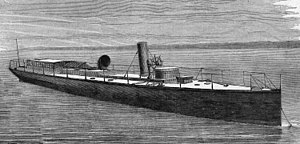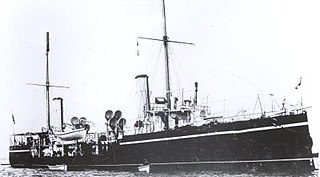
A torpedo boat is a relatively small and fast naval ship designed to carry torpedoes into battle. The first designs were steam-powered craft dedicated to ramming enemy ships with explosive spar torpedoes. Later evolutions launched variants of self-propelled Whitehead torpedoes.
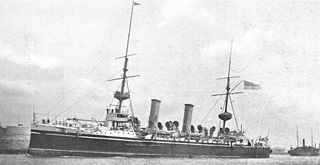
HMS Minerva was an Eclipse-class protected cruiser built for the Royal Navy in the mid-1890s.

HMS Andromache was an Apollo-class protected cruiser of the Royal Navy. William Henry White designed her, and she was built at Chatham Dockyard and launched on 14 August 1890. The total cost of construction was £186,234.
HMS Zebra was a "Twenty-seven Knotter" destroyer of the Royal Navy, later classified as part of the A Class. Zebra was built by Thames Iron Works and launched in 1895 as the fifth Royal Navy ship to be named Zebra. Entering service in 1900, Zebra was sold for scrap in 1914.

HMS Crescent was a first class cruiser of the Edgar class in the British Royal Navy. Crescent, and her sister ship Royal Arthur, were built to a slightly modified design and are sometimes considered a separate class. She was launched in 1892, saw early service at the Australia Station and the North America and West Indies Station, served in the First World War, and was sold for breaking up in 1921.

HMS Sea Scout was a S-class submarine of the third batch built for the Royal Navy during World War II. She survived the war and was sold for scrap in 1965.
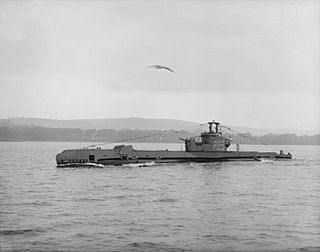
HMS Seneschal was a S-class submarine of the third batch built for the Royal Navy during World War II. She survived the war and was sold for scrap in 1965.
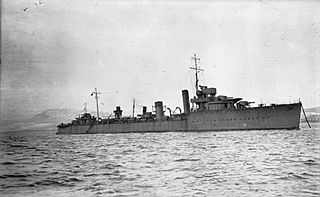
HMS Warwick (D25) was an Admiralty W-class destroyer built in 1917. She saw service in both the First and Second World Wars, before being torpedoed and sunk in February 1944.
HMS Haughty was a Hardy-class destroyer which served with the Royal Navy. She was launched by William Doxford & Sons on 18 September 1895, served in home waters, and was sold on 10 April 1912.
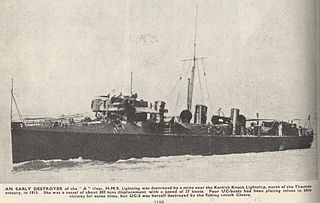
HMS Lightning was a Janus-class destroyer of the British Royal Navy, later designated an A-class destroyer, built by Palmers and launched in 1895.
HMS Porcupine was a Janus-class destroyer of the Royal Navy. She was launched by Palmers Shipbuilding and Iron Company in 1895, served in home waters and was in service during the First World War.

HMS Lynx was a Ferret-class destroyer which served with the Royal Navy. She was launched in 1894 and sold in 1912.

HMS Decoy was a Daring-class torpedo boat destroyer which served with the Royal Navy in home waters. She was launched in 1895 and sunk in a collision with the destroyer HMS Arun in 1904.

HMS Wizard was a Conflict-class destroyer built by the White shipyard for the Royal Navy, and launched on 26 February 1895. In 1910, she was reconstructed with only two funnels. She is believed to be the only destroyer fitted with in turning screws. She was sold in 1920.
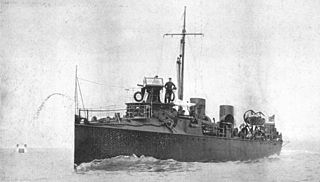
HMS Hunter was one of three Handy-class destroyers built for the Royal Navy in the 1890s. Completed in 1896 she spent her career in home waters and was sold for scrap in 1912.

HMS Sturgeon was the lead ship of the Sturgeon-class destroyers which served with the Royal Navy. Built by Vickers, she was launched in 1894 and sold in 1910.
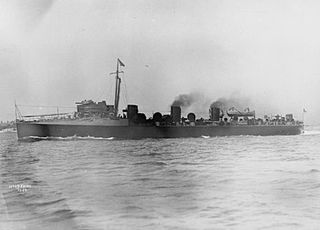
HMS Gipsy was a Fairfield-built three-funnel, 30 knot torpedo boat destroyer ordered by the Royal Navy under the 1896 – 1897 Naval Estimates. She was the fourth ship to carry this name. Designated as a C-class destroyer in 1913, Gipsy served on patrol in the First World War operating out of Dover. She was sold for breaking in 1921.
HMS Vesuvius was an experimental torpedo-armed warship of the British Royal Navy. Built by Pembroke Dockyard in 1873–1874, she was the first purpose-designed torpedo vessel built for the Royal Navy. Vesuvius was intended for night attacks against enemy harbours, and was armed with a single tube for Whitehead torpedoes in her bow. She was used for experimental and training purposes, and was not disposed of until 1923.
HMS TB 81, originally named Swift, was a torpedo boat that served with the British Royal Navy. She was built in 1884–1885 by the shipbuilder J Samuel White as a private venture, and was purchased for the Royal Navy in 1885, and was one of the largest torpedo boats of her time. She remained in service into the First World War, when she was employed as a patrol boat, finally being sold for scrap in 1921.
